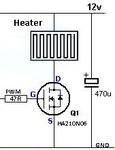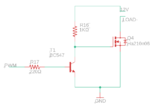Boo123
Newbie level 5

Hello everyone,
I'm working on a project that controls 12Vdc 7Amp silicon heater pad using MOSFET.
I tried HA210N06 MOSFET with a heatsink but it doesn't work correctly, the heater doesn't get hot but the MOSFET is getting very hot, I tried another lower amper heater it's work but also not get very hot with a 100% duty cycle as I connect it directly to the power supply.
I'm using dual output power supply 5v for microcontroller and 12v 15A for the heater.
PWM frequency is 500hz.
I'm using pic 18f4685 and programming with MikroC.
The circuit is attached.
my question is this MOSFET could work correctly but I have some connections problem or coding problem?
Thank you.
I'm working on a project that controls 12Vdc 7Amp silicon heater pad using MOSFET.
I tried HA210N06 MOSFET with a heatsink but it doesn't work correctly, the heater doesn't get hot but the MOSFET is getting very hot, I tried another lower amper heater it's work but also not get very hot with a 100% duty cycle as I connect it directly to the power supply.
I'm using dual output power supply 5v for microcontroller and 12v 15A for the heater.
PWM frequency is 500hz.
I'm using pic 18f4685 and programming with MikroC.
The circuit is attached.
my question is this MOSFET could work correctly but I have some connections problem or coding problem?
Thank you.






